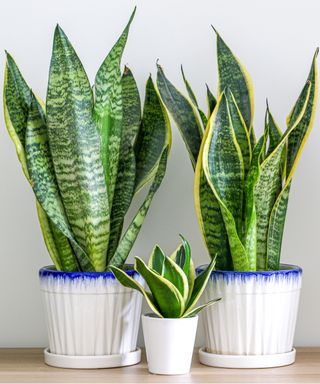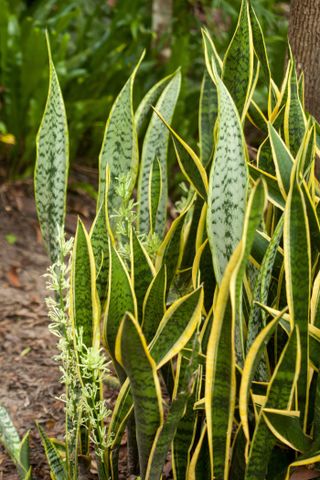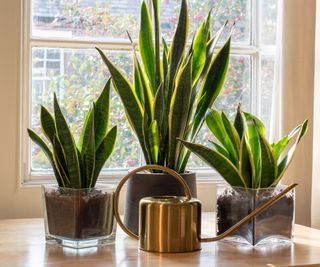Snake plants, otherwise known as dracaena trifasciata, are among the most popular choices for indoor plants. Coming in a variety of sizes and colors, their bold, vertical foliage is a winner for many homeowners, adding visual interest without taking up too much space.
Although learning how to care for a snake plant indoors isn’t too difficult, many gardeners ask the question, can snake plants live outside? While this is possible, there are rules to follow to ensure that these tropical-looking plants thrive.
Here, experts reveal all you need to know about outdoor snake plant care, including ideal climate and US hardiness zones, as well as when it’s necessary to take your snake plant back indoors.
Can my snake plants live outside?

(Image credit: Adam Yee via Getty Images)
Although snake plants are seen as one of the best indoor plants, they can live a long and happy life outdoors too, either in the ground or in a pot, permitted you live in the correct climate for them to thrive.
Jessica Mercer, senior content marketing coordinator and plant expert at Plant Addicts, says: ‘Snake plants are native to tropical West Africa, where conditions are hot and dry. So, it goes without saying, these succulents are incredibly sensitive to frost and excess rainfall, and are only hardy in zones 9-11.’
You can find out what hardiness zone you live in by looking up your area on the USDA Plant Hardiness Zone Map. US hardiness zones 9 to 11 are considered to be warm climate regions, and are typically found in the more southern states of America, including Texas, Florida and California.
What climate does an outdoor snake plant require to thrive?

(Image credit: Cavan Images via Getty Images)
Being particularly prone to temperature stress, the most important factor to consider when seeking to grow a snake plant outdoors is whether the temperature in your area is prone to fluctuating.
A snake plant can’t withstand prolonged exposure to cold and consistently changing temperatures, so if your location frequently dips below 40°F, your snake plant will struggle to survive outdoors.
‘This type of plant prefers temperatures between 70 and 90°F (21-32°C) and cannot live in colder temperatures outdoors,’ says Jessica. ‘If you are lucky enough to garden in an area with mild winter weather though, these adaptable plants will relish the extra sunlight, humidity, space, and air circulation of the outdoors.’
The MUMTOP outdoor metal owl garden thermometer from Amazon will help you to keep track of the temperature in your yard, without looking unsightly. But, if you’d prefer something more technical to help you keep track of each day’s data, Amazon’s Govee hygrometer with Bluetooth will do just the trick.
If your area still has adequate sunlight, little rain, and a relatively mild temperature during parts of the year, you could still keep a snake plant outdoors in a pot, but not in the ground.
Calvin Li, owner of PAFE Plants, recommends asking yourself the following four questions about your climate to determine whether you could plant a snake plant outdoors in the ground:
- Does your climate stay mild all year round (between 50 and 90 degrees)?
- In the spot where you want to plant your snake plant(s), will the right amount of sun (ranging from partial shade to 3-4+ hours of sun) beam?
- Is the area protected from the rain, or does your climate not get much rain?
- Is your climate moderately humid?
‘If you don’t meet all those criteria, you can still take your snake plant outside, but keep it in a pot, because it can’t stay outside year-round,’ says Calvin.

Calvin Li grew up helping customers pick out the perfect plants for their homes and offices—and he even advised Saks Off Fifth as they selected plants for their corporate offices. He then went on to study horticulture in college, and now he’s expanded his family business online, PAFE Plants (standing for ‘Plants Are For Everyone’). Every day, customers come into his shop with all sorts of plant questions, and he loves helping them select plants and solve problems.
Where should an outdoor snake plant live in the yard?

(Image credit: Alamy/ Stephanie Jackson – Gardens and flowers collection)
When putting a snake plant in a pot outdoors, seek to place it in an area out of direct sunlight. As much as snake plants require a decent amount of sunlight to grow healthy, the sun beaming down onto them all day will rapidly cause their leaves to burn, or the snake plant to begin dying.
If your area experiences significantly colder months during winter, it’s recommended to bring your potted snake plant back indoors until the season is over.
Snake plants in the ground don’t have this ease during cold weather: when the temperatures drop, your plant will still be outside. Assess whether the cold weather will be too much of a temperature drop for your plant to handle. If your area only experiences mild winters, you can go ahead and plant your snake plant in the ground in an area shielded from direct sunlight that has good drainage.
‘Position your snake plant in a location with excellent drainage and protection from hot afternoon sun,’ says Jessica. ‘Allow the soil to dry out between waterings too because these plants do not tolerate wet feet or overwatering.’

Jessica Mercer, PhD, is the Senior Content Marketing Coordinator for Plant Addicts. As a “plant collector”, Jessica enjoys growing many different plants and learning about the best culture practices for each. Writing for Plant Addicts is a real joy for her, as she can use her science background to research interesting plant topics. She carefully considers how to best present the information to other gardeners, with a focus on sustainability and the environment.
How often should I water my outdoor snake plant?

(Image credit: Grumpy Cow Studios via Getty Images)
If you’re wondering how often to water a snake plant, it’s relatively simple but differs depending on whether your plant is potted or planted in the ground.
A potted snake plant benefits from being watered every two weeks during warmer months and once a month or less in the winter.
Ofra Gaito, CEO of Verdant Lyfe plant shop, says: ‘The number one cause of snake plant leaves falling over is too much water. Overwatering makes the soil soggy, keeps roots from breathing, and causes plants to rot and die. Allow the soil to dry between watering or you can make a rule for yourself to water the plant on the 1st and the 15th of each month. In the rainy season, lessen this to once a month.’
If your snake plant is growing in the ground, watering should be more frequent but monitored carefully. Once a week in warm weather and approximately every three weeks in winter should suffice.
To help you keep track of the moisture level of your soil, we recommend investing in a moisture meter, such as the XLUX soil moisture sensor from Amazon. This neat little device will blend in with the greenery of your plant and provide you with a straightforward reading of whether your soil is dry, moist, or too wet.

In 2020 Ofra Gaito founded Verdant Lyfe, an e-commerce company born to help and share live plants with both plant lovers and new plant beginners. The company packs and ships hundreds of orders every week to homes and businesses all over the USA. At the head office in South Florida, Ofra and her team conduct workshops every six weeks that involve the plant world. Ofra hosts live radio program Grow Your Lyfe every Friday at 1:45 pm EST on 101.9FM Omega radio.
Does an outdoor snake plant require any additional care?

(Image credit: Inna Luzan / Getty Images)
If your snake plant is directly planted into the ground, it won’t require any particular additional care. However, if your snake plant spends part of the year inside and part of the year outside in a pot, you will need to properly acclimatize it every time it makes the shift from indoors to outdoors.
Without gradually making this shift, your snake plant will enter a state of temperature shock and potentially be unable to bounce back.
‘If you’re moving your snake plant outdoors from indoors you need to do it gradually,’ says Calvin. ‘The snake plant is not a big fan of major changes. So over a week or two, slowly give it more light. If you go from partial shade to direct sun, it will just burn. But if you go from partial shade to medium direct light, to bright indirect light, to a bit of direct sun, then it will continue to thrive.’
Calvin expands on this by sharing the following two suggestions to help acclimatize your snake plant:
‘You have two options. Option one is taking your snake plant outside for a bit of sun, and then moving it back inside for a bit of shade. But that’s a lot of work. Option two is just moving it around outside. Put it in an outdoor spot with the exact kind of light it had inside. Then, give it a few days to acclimate to the different humidity levels outside. After this, move it into light that is one level brighter, and wait a few days.’
Did you know that snake plants are one of a selection of plants that act as a natural air-cooling solution? It’s just another of this plant’s amazing properties, so if your home struggles in the summer, snake plants are a great choice.
Snake plants, also known as dracaena trifasciata, are a popular choice for indoor plants due to their bold, vertical foliage that adds visual interest without taking up much space. They come in various sizes and colors.
While caring for a snake plant indoors is relatively easy, many gardeners wonder if snake plants can thrive outdoors. It is possible, but certain rules must be followed to ensure their success.
Experts share insights on outdoor snake plant care, including ideal climate conditions, US hardiness zones, and when to bring your snake plant back indoors.
Can my snake plants live outside?

(Image credit: Adam Yee via Getty Images)
Snake plants, while commonly indoor plants, can also thrive outdoors in the right climate conditions. They are sensitive to frost and excess rainfall, and are hardy in zones 9-11, which are warm climate regions found in southern states like Texas, Florida, and California.
It’s important to know your hardiness zone by referencing the USDA Plant Hardiness Zone Map to determine if your area is suitable for outdoor snake plants.
What climate does an outdoor snake plant require to thrive?

(Image credit: Cavan Images via Getty Images)
Outdoor snake plants need a consistent temperature range to thrive. They prefer temperatures between 70-90°F and cannot tolerate colder temperatures. Areas with mild winters, extra sunlight, and good air circulation are ideal for outdoor snake plants.
It’s essential to consider factors like temperature stress, sunlight exposure, and humidity levels in your area before deciding to plant a snake plant outdoors.
If your area meets the criteria of mild temperatures, adequate sunlight, low rainfall, and moderate humidity, you can keep a snake plant outdoors in a pot but not in the ground.
It’s recommended to assess these factors before deciding to plant a snake plant outdoors in the ground to ensure its survival and growth.
Where should an outdoor snake plant live in the yard?

(Image credit: Alamy/ Stephanie Jackson – Gardens and flowers collection)
When placing a snake plant in a pot outdoors, it’s important to avoid direct sunlight, as too much sun exposure can damage the leaves. If your area experiences cold winters, consider bringing potted snake plants indoors during winter.
Snake plants in the ground require well-draining soil, protection from hot afternoon sun, and minimal watering to prevent root rot. Proper soil moisture and good drainage are essential for the health of outdoor snake plants.
How often should I water my outdoor snake plant?

(Image credit: Grumpy Cow Studios via Getty Images)
For potted snake plants, water every two weeks in warmer months and once a month or less in winter. Ensure the soil dries out between waterings to prevent overwatering and root rot.
For snake plants in the ground, water approximately once a week in warm weather and every three weeks in winter. Use a moisture meter to monitor soil moisture levels and prevent overwatering.
Does an outdoor snake plant require any additional care?

(Image credit: Inna Luzan / Getty Images)
When transitioning a snake plant from indoors to outdoors, acclimatize it gradually to prevent temperature shock. Gradually expose the plant to more light over a period of time to help it thrive in its new environment.
Proper care and gradual adjustment are crucial for the health and growth of snake plants when transitioning between indoor and outdoor environments.
